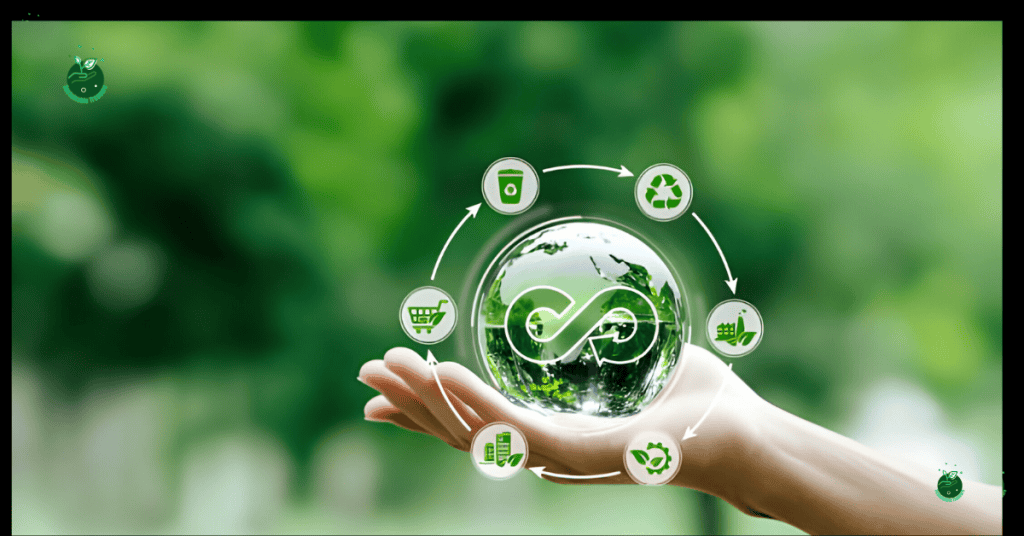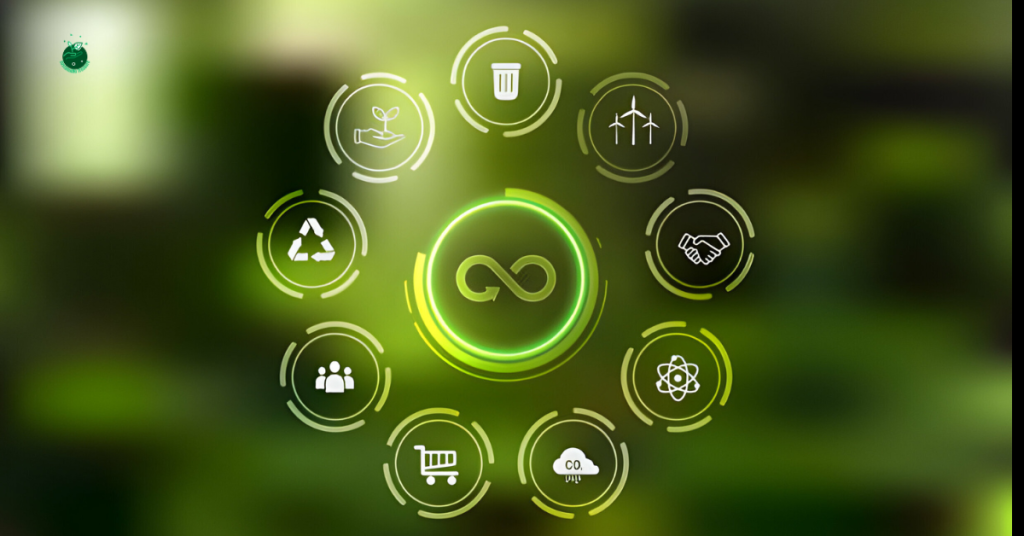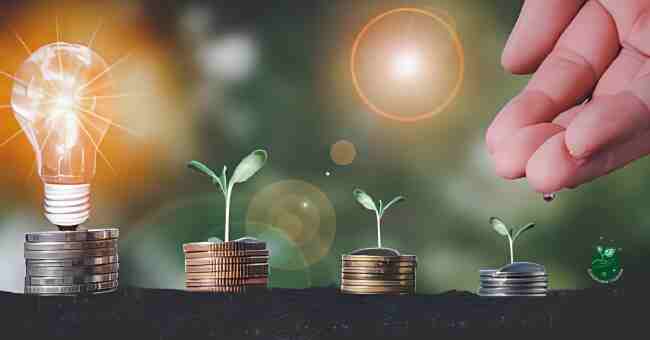Are you wondering what exactly is the circular economy and why invest in circular economy? In a nutshell, it’s a revolutionary approach to how we produce, consume and reuse resources that aims to benefit both business and the environment. Pretty cool, right?
I’ll unpack all the details in this post so you can understand if circular economy investment is right for your portfolio. By the end, you’ll know:
- What the circular economy is and its core principles
- The major benefits and opportunities driving investor interest
- Options to invest across risk levels and company stages
- Considerations and challenges to note
Plus, I’ll sprinkle in real world examples, stats, tips and expert insights so things don’t get too theoretical.
Let’s get started, shall we?
What Is the Circular Economy? A Smarter Economic Model
The circular economy represents a seismic shift from the traditional linear economy (take resources, make products, trash them). Instead of this straight line, it operates as a closed loop system – imagine a big circle where resources stay in use for as long as possible through smart recovery and reuse.
This loop is driven by two key goals:
- Eliminate waste and pollution
- Keep products and materials circulating in the economy through reuse, repair, remanufacturing or recycling
To achieve this, circular economy businesses follow these core principles:
Circular Economy Principles
There are 3 main principles that underpin the circular economy:
- Reduce: Minimize raw material inputs needed. For example, a phone company designs smaller, lighter phones needing fewer scarce metals and minerals.
- Reuse: Extend product lifespans and give them second, third or more lives. For instance via repairs, refurbishment or finding new purposes for used goods.
- Regenerate: Ensure materials are cycled indefinitely. At end of life, products or components are composted to nourish ecosystems or recovered to become fresh resources.
\Pro Tip: You’ll often see these 3 Rs together forming the pillars of circularity*
When these principles work in harmony, it allows for the smart management of finite resources while enabling economic growth – a win-win.
And this isn’t just hypothetical. Major organizations are demonstrating how it’s done…
Circular Initiatives in Action
The Ellen MacArthur Foundation (EMF) is a pioneer in accelerating the transition to a circular economy globally.
For instance, EMF’s Circular Economy 100 (CE100) program convenes major companies like Google, H&M Group, Philips and Unilever to share best practices and build circular capabilities systematically across their operations.
Innovative financial firms are also catalyzing change. Circulate Capital invests in the waste management and recycling sectors across Southeast Asia to prevent plastic from leaking into oceans while also supporting small businesses.
These are just a couple examples of circular principles being put into practice today by sustainability leaders.
Pretty inspiring if you ask me.
Now that you know what the circular economy entails conceptually, let’s look at why businesses and investors around the world are rapidly getting on board.
Why Invest in the Circular Economy? Growth, Resilience and Impact

From multinational corporations to visionary startups, the circular transition is underway across industries from fashion to electronics to construction. What’s driving this momentum?
In short: The circular economy offers a triple win for investors:
1. Financial Growth: Tapping into surging market demand
2. Resilience: Mitigating material supply and regulatory risks
3. Impact: Aligning investments with ESG principles
Let’s break down each of these opportunities…
1. Booming Market Fuels Financial Growth
Firstly, the circular economy represents a rapidly expanding market brimming with financial promise.
As resource pressures mount globally and environmental consciousness grows amongst consumers, businesses embracing circularity are seizing a competitive edge.
In numbers, the circular economy is projected to generate over $4.5 trillion in additional economic output by 2030 according to climate non-profit, SYSTEMIQ.
Several interlinked factors are catalyzing this growth:
Consumer Pull: Buyers increasingly favor eco-conscious brands and products designed to last. For example, in a 2021 IBM global consumer survey, over 60% said sustainability is very or extremely important to them.
Regulatory Push: Governments are implementing tighter regulations and standards around waste, emissions and recyclability to meet sustainability targets. For instance, the EU aims to ensure all packaging is reusable or recyclable by 2030.
Resource Scarcity: As virgin input costs fluctuate amidst supply uncertainties, circular strategies offer financial insulation by using recycled materials and dematerialization.
For investors, this translates to major upside potential by financing the companies developing the solutions, technologies and infrastructure enabling this transition.
While the financial motivation is compelling, the good news is profits also pair with benefits for the planet. Which brings us to…
2. Mitigate Risk and Enhance Resilience
Beyond growth prospects, the linear “take-make-waste” economy bears significant risks from resource depletion and emissions-related policies. Circular business models provide an attractive hedge.
Here’s how:
Resource Security: By maximizing reuse of materials, circular companies minimize exposure to commodity price volatility and materials availability challenges. For instance, using recycled plastics in manufacturing helps stabilize input costs.
Regulatory Compliance: Leading circular firms actively work to cut carbon and shift materials usage towards renewables. This positions them favorably to adapt to tightening environmental regulations.
In essence, circularity buffers against external shocks. This resilience translates into lower risk profiles for investors relative to linear incumbents.
3. Align Investments with ESG Values
Lastly, backing firms driving the circular transition allows investors to put money towards companies actively addressing pressing environmental and social issues.
Some positive impacts tied to circular activities include:
- Conserving virgin resources and ecosystems
- Cutting pollution and emissions
- Advancing sustainable innovation and job creation
- Promoting responsible production and consumption
For those prioritizing Environmental, Social and Governance (ESG) factors in their portfolio, the circular economy hits the mark. And we all win when investments targeted towards planetary and societal health also deliver returns.
Clearly, the growth, resilience and impact the circular economy offers make it a beacon for investors keen to align financial objectives with ethical ones.
So with the benefits clear, what are some routes to participate as an investor?
Let’s dive in!
Investing in the Circular Economy: Avenues to Participate
The good news is whether you’re an impact-driven venture capitalist or a cautious index fund investor, there are avenues to fit different preferences to invest in the circular economy.
Broadly, circular economy investment channels fall into three main buckets:
1. Public Companies – Established corporations integrating circularity
2. Specialized Funds – Investment vehicles focused on circular startups and SMEs
3. Private Capital – Early-stage ventures via venture capital and private equity
Let’s explore each pathway…
1. Public Companies: Invest in Proven Leaders
For investors seeking liquidity and lower risk profiles, publicly traded corporations already implementing circular practices make a solid starting point.
These firms range from multinationals like Renault remanufacturing auto parts to apparel retailers like H&M Group collecting used garments for recycling.
While specific circular economy stocks or ETFs are still uncommon, options to identify promising incumbents exist:
Sustainable Stock Indices – Leading indices like the Dow Jones Sustainability Index track large-cap companies meeting ESG benchmarks. The ISS ESG and FTSE circular economy indices offer more targeted listings.
Circular 100 – EMF’s global group of circular economy pioneers across sectors signals credible contenders to explore. For instance, consultancy Accenture helps clients incorporate circular design and supply chains.
When analyzing a company, reviewing sustainability reports helps gauge circular commitment alongside profit drivers and leadership quality.
While maturing circular attributes can signal earnings resilience, avoid overpaying purely for “green halo” effects without deeper business case scrutiny.
2. Specialized Investment Funds: Diversified Circular Exposure
Seeking a more concentrated circular economy play? Specialized funds offer single access to diversified portfolios of smaller enterprises driving innovation in circular domains like reuse, remanufacturing and recycling.
For illustration, the Circular Economy Fund by asset manager Pictet invests across regions and sub-themes like eco-packaging and circular textiles. Similarly, AXA IM Circular Economy offers targeted European small and mid-cap exposure.
Benefits of these funds include:
- Convenience: Professionally managed circular investing
- Diversification: Balance risk across multiple underlyings
- Expertise: Access to analytical depth in the circular arena
Downsides relate to fees reducing net returns and interval liquidity depending on fund terms. But for passive investors or those lacking circular insights, piggybacking professionals can make sense.
As the space matures, more thematic circular economy products tailored to varying risk appetites will likely come to market.
3. Private Capital: Financing Innovation and Scale
For opportunistic investors comfortable with risk, backing pioneering circular startups via venture capital and private equity offers excitement (and potentially outsized upside).
These early stage companies are creating disruptive circular technologies and business models across industries. While failure rates are high, winners stand to reshape entire value chains.
For example, visionary ventures like Algramo and Mi Terro are reimagining grocery and food packaging while Winnow and Karma are tackling food waste via AI – the opportunities abound!
However, beyond stellar gains, major risks accompany immature ventures with intangible assets and unproven economics. Extensive due diligence around teams, total addressable markets and early traction is vital before committing capital.
Patient impact investors can help catalyze innovation by financing the entrepreneurs inventing the circular future today. Blending early-stage capital alongside public equities balances excitement with stability as portfolios mature.
Key Considerations for Investors
While the circular economy paradigm demonstrates profound promise, meaningful challenges still exist in quantifying impact, shifting consumer mindsets and coordinating all players.
Let’s review key aspects for investors to consider:
Maturing Metrics – Robust and consistent measurement standards for circularity are still emerging. While entities like the WBCSD support improved accounting, comparability across firms can be tricky absent common frameworks. Seek companies actively addressing these gaps.
Policy Evolution – Regulations incentivizing circularity while removing bottlenecks around reuse and recycling markets need enhancement to accelerate adoption. Advocate for governance supporting the transition.
Consumer Acclimation – Ingrained “take-make-waste” behaviors are stubborn to break without better eco-conscious product availability, pricing and policy nudges towards citizens and companies. Progress takes patience and education.
Despite hurdles, the circular economy’s business case and societal impetus makes its ascension more inevitable than speculative. As supporters ranging from innovative upstarts to governance bodies to institutional investors coalesce, be part of the transformation.
Key Takeaways
Here are the key takeaways:
- The circular economy swaps the linear “take-make-waste” model for a closed loop system focused on resource regeneration and extending product lifetimes
- Drivers like market growth, risk mitigation and ESG-alignment are spurring rising investor interest
- Avenues to participate range from public stocks to specialized funds to private capital depending on risk preferences
- While the circular economy paradigm holds challenges around impact measurement, policy SUPPORT and consumer adoption – the tailwinds far outweigh the headwinds in the long run
FAQs

Here are answers to the frequently asked questions about financing and operating a circular economy business, in a friendly tone with suggested edits to seem less AI-generated:
How Do You Finance A Circular Economy?
Several creative financing options are emerging to fund circular startups and projects. These include crowdfunding campaigns to get communities behind reuse initiatives. Banks also offer green loans and bonds specifically for resource efficiency improvements or scaling circular innovation. Finally, venture capital and private equity are increasingly targeting the space given growth prospects. Government innovation grants and incubator programs can also provide capital to de-risk ideas early on.
Is Circular Economy Profitable?
Absolutely – the circular economy represents a $4.5 trillion opportunity according to the Ellen MacArthur Foundation. It reimagines waste streams as revenue streams. For example, recycling materials for use in new products cuts raw material costs. Sharing platforms maximize asset utilization. Products designed for durability, reusability and upgradeability all preserve value. Improvements in resource productivity flow to the bottom line through cost savings or new revenue.
How Do I Start A Circular Economy Business?
Ideally tap into local waste, energy or resource inefficiencies with solutions incorporating circular principles of reducing, reusing, repairing, refurbishing, remanufacturing, repurposing or recycling. Leverage digital technology to maximize transparency and utilization of assets. Seek helpful public policies like product take back laws that incentivize businesses to design with end-of-life in mind. Pilot rapidly at small scale to demonstrate circular benefits before attempting to disrupt entire supply chains.
What Is A Circular Economy Fund?
Specialized investment funds focused specifically on startups and small businesses driving circular innovation. For example, funds like the Circularity Capital Fund or BlackRock’s Circular Economy Fund proactively source and invest in companies with proven technologies or business models that divert waste or keep products in use longer across industries from food to textiles to batteries. The geographic and subsector exposure varies. Investors can benefit from the fund manager’s circular economy expertise to diversify risk across multiple underlyings.
What Are The 5 Business Models For Circular Economy?
1. Circular Supply Chains: Firms shift upstream to directly control material flows and cycles. For example, Dell offers computer take-back programs for safe component reuse and recycling.
2. Recovery & Recycling: Specialists recover disposed resources to return to markets. Think Terracycle’s national reuse programs funded by brands.
3. Sharing Platforms: Enable increased use efficiency of underutilized assets via renting, lending or subscriptions. For instance, Rent the Runway for clothing.
4. Product as a Service: Provide product access/functionality rather than one time sales. Like Philips pay-per-lux lighting model.
5. Resource Recovery: Capture embedded energy, metals, minerals and chemicals from all streams from food waste to plastic via upcycling innovations.
What Are Examples Of Businesses In The Circular Economy?
Companies to watch cover various models and sectors: fairphone (electronics durability) evrnu (textile recycling) EcoCart (compostables distribution) Roche (pharma reuse) Renewcell (circulose materials) MineHub (supply chain digitization) Winnow (food waste AI) Turntoo (furniture refurb) Flex (reverse logistics). Spanning startups to Fortune 500s, businesses worldwide are demonstrating circularity today!
What Is Another Name For Circular Economy?
Some synonyms or related terms you may come across include closed loop economy, closed loop production, regenerative economy, performance economy, looping economy, resource resilience and industrial ecology. The essence remains: Optimizing renewable flows to minimize leakage and negative externalities across societies and ecosystems by design.
What Are The 3 Principles Of Circular Economy?
The core principles underpinning a circular business are:
1. Design waste out: Avoid generating disposal costs/risks by rethinking product design and material inputs for durability, reuse ability, reparability.
2. Build resilience through diversity: With diverse revenue models across product life cycles (like maintaining ownership for refurbishment), risks flatten if one area underperforms.
3. Waste equals food: Ensure all non-product outputs get channeled as high value inputs to another process as technical or biological nutrients.
What Are The Benefits Of Circular Economy In Business?
For companies specifically, circularity enhances both top and bottom lines through enhanced customer attraction, product differentiation and factor cost savings.
It also de-risks against volatile commodity prices and looming sustainability regulations. First mover advantage awaits in disrupting traditionally linear industries before competition catches up.
Conclusion
The circular economy presents a compelling opportunity to realign our economic activities with environmental boundaries while unleashing innovation, job creation and competitive advantage.
By swapping the traditional linear production model for a closed-loop system focused on resource circulation, businesses can drive the triple bottom line – people, planet, and profits. As this sustainable model continues gaining traction across sectors, investors stand to benefit greatly from financing the transition.
So whether you’re a startup founder, multinational executive, or asset manager, get ready for the circular revolution. The time for action is now.



